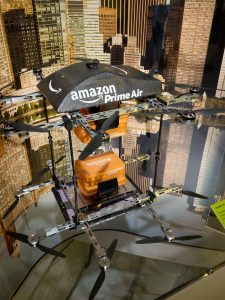The flying taxi industry looks promising, but lack of regulations, revenue, and public acceptance will hinder its evolution.
Our modern society hasn’t lived up to every futuristic, technological expectation of 1950s America. While we have the talking robots, the spaceships that land upright and even the Dick Tracy two-way Wrist Radio, we still don’t have flying cars.
Despite the likely disappointment of those mid-century Americans, they’d still take pride in the fact that flying taxis are becoming a reality, one with massive market potential. It is not so much a question of if someone will be able to avoid LA traffic by flying taxi, or if a New Yorker could comfortably coast above the city skyline, but when.
The flying taxi prototype market is surprisingly crowded, with a mix of burgeoning startups and well-established business behemoths. Here’s a snapshot of the diverse companies and corporations throwing dollars at these flying vehicles:
How near or far that “when” is may depend on how the industry adapts and responds to the various barriers facing flying taxis. These barriers aren’t so much in the realms of technology and production, but the larger scale, societal and economic forces that may ground the reality of flying taxis before they even take flight.
Regardless of how advanced or innovative a particular automobile may be, it and its designers, manufacturers and drivers still must comply with regulations from organizations such as the Department of Motor Vehicles and the National Highway Traffic Safety Administration. Regulations are also present for those who participate in air travel: the Federal Aviation Administration (FAA) helps govern the actions of pilots and air traffic controllers, while the Transportation Security Administration works to ensure passengers do not carry harmful or hazardous materials onto airplanes. And these federal regulators of personal and commercial auto and truck transportation are supplemented by various state and local regulations and restrictions.
As for flying taxis, there is no equivalent of an FAA. There are no federal safety regulations for flying taxis, no licenses or guidelines for its drivers, no specific regulations on altitudes and routes and no specific safety requirement. And there are no insurance policies for those who wish to ride in such a vehicle or have their vehicles themselves protected from potential harm.
That’s not even taking into account the various policies that would need to be implemented on a state level. What would be the maximum altitude that a flying taxi could drive in downtown Chicago versus suburban San Diego? How would state legislators measure how Colorado blizzard conditions impact drivers, or how Nevada heat waves may wear out a flying vehicle?
These regulatory processes aren’t impossible to achieve, but every one of them requires dedication and deliberation from a variety of parties and stakeholders, sometimes with conflicting goals and interests. All of that adds up to more time in-between the perfection of flying taxi technology and its large scale rollout.
There is no doubt that the ability to safely avoid traffic and shorten trips using a flying car or taxi will be in high demand in urban environments. So there is no doubt that flying taxis have the potential to be a multi-billion dollar industry, one that fosters exponential economic growth. But in its initial and early market phases, manufacturers and operators are likely going to lose money. And unlike the early auto industry, the participants include both small innovators and larger enterprises.
Early flying taxi prototypes are being developed by lesser-known innovators, like the German start-up Lilium, and being targeted by established corporations, such as Boeing. The smaller startups are able to make a name for themselves and survive throughout the future thanks to flush investor cash. The legacy corporations don’t have to worry about flying taxi profit or revenue, citing their efforts instead as prestige projects.
But because of the lengthy regulatory rollout, many of these smaller firms will not survive and by 2040, there would likely be two or three major manufacturers of flying taxis reaping most of the financial rewards similar to what we’ve seen in other transportation industries. There would still be innovators and amateurs following in their stead, but the market would be primarily controlled by those who could sustain the financial windfall of developing the technology, all while providing an innovative and accessible product to consumers.
Of course, the growth of a flying taxi market depends on the need for things to be transported in the first place. In this case, passengers must have a need to be transported by flying taxi, be able to afford such a service and be comfortable with actually traveling by such a vehicle. If we look at the early auto industry as an example, this large scale consumer acceptance may take decades despite a number of early adopters.
Initially, we can expect drone-like, on-call electric vehicles with remote or autopiloting for short trips in urban areas likely from high demand point-to-point trips from terminals in city centers and airports. A passenger may not be comfortable with the idea of traveling in an autopilot flying taxi from Los Angeles to San Francisco, but the idea of taking one 15 miles across town without a pilot might seem more reasonable.
There will likely be safety concerns and consumer acceptance setbacks along the way. Any sort of flying taxi crash or accident could spark widespread media scrutiny and ward off potential new customers to the service. But over time, those fears and hesitations will erode as the public becomes more familiar with this kind of technology.

Amazon’s Prime Air cargo delivery offers services that include 30-min delivery for members.
But before we see the large scale acceptance of flying taxis and vehicles for passengers, we are very likely to see widespread adoption of flying vehicles supplementing existing cargo transportation and package delivery.
We are already seeing the commercial rollout of point-to-point air cargo delivery like Amazon’s Prime Air delivery application of drone technology promising 30-minute delivery service. So it is likely before we step into our first flying taxi for passenger service, we will enjoy the benefits from this technology as a more efficient alternative to current options for “rush” shipping on anything from consumer goods purchased online to transporting items needed ASAP by manufacturing, health care and general business purposes.
After a few years of successful cargo shipping with few to no mishaps or incidents, the public would warm up to the idea of actually riding in such a vehicle similar to what we are seeing in space travel. Even by that point, the true market potential won’t be in enabling travelers to go to different places faster, but in more efficiently transporting goods and products to people where they already are.
No matter how the flying taxi industry evolves or takes shape, history suggests that there will be some element of consumer resistance at play. The introduction of air travel in the 1950s wasn’t met with unanimous praise, but with skepticism and fear by some who swore they would never find themselves strapped into a seat aboard a flying piece of metal in the sky. But as we sit in our autonomous driven vehicle in yet another traffic jam and use our smartwatch to contact our kitchen robot to keep dinner warm, we will likely get on board with the flying taxi concept.
Today, commercial air travel is a widely-accepted mode of transportation for millions across the world. Flying taxis could very well achieve a similar trust in the future.

Prof. Richard Kilgore
Professor Richard Kilgore, Instructor in the Online Management and Business Administration program at Maryville University
In this episode, I sat down with Beejan Giga, Director | Partner and Caleb Emerson, Senior Results Manager at Carpedia International. We discussed the insights behind their recent Industry Today article, “Thinking Three Moves Ahead” and together we explored how manufacturers can plan more strategically, align with their suppliers, and build the operational discipline needed to support intentional, sustainable growth. It was a conversation packed with practical perspectives on navigating a fast-changing industry landscape.